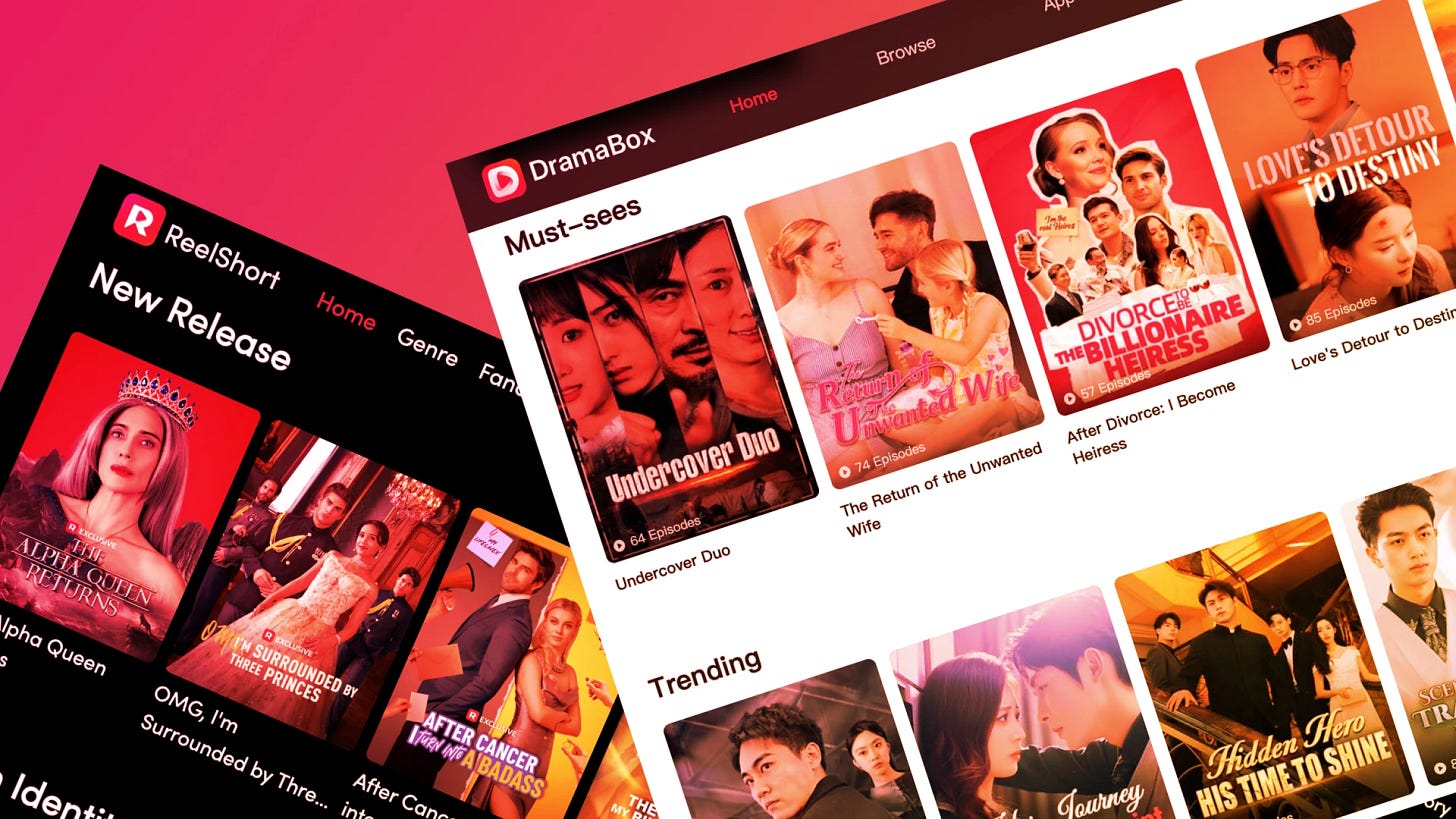You may or may not have heard of micro-dramas, but you probably should have. Or maybe you have, but don’t get what all the fuss is about?
Many signs suggest this is far more than fleeting tech or entertainment fad, potentially holding the keys to deeper engagement across many markets that are mobile-first, and entirely ready for a new way of consuming stories (and parting with loose change).
After sitting on a draft primer on the format for many weeks, I was finally moved to put this out because of some stunning numbers coming from the home of the format- China:
Micro Dramas Just Beat China’s Box Office. Wait, what?
In 2024, micro dramas in China made more money than the country’s entire box office. These ultra-short, mobile-first scripted series generated over $6.9 billion in revenue.
So, what exactly are they, why are they growing so quick, and how much attention should the rest of the world be paying?
The What.
At their core, micro dramas are bite-sized, bingeable TV shows designed ground-up for mobile viewing in the TikTok age. But- unlike TikTok or Reels, these are not influencer skits, or fun dances or little nuggets of wisdom. Fully scripted, high-intensity narratives, these have plots that move at lightning speed to keep viewers hooked. Think 60-90sec episodes that leave you wanting more, every time. Some might run up to 3min, and runs could have 50-100 eps. You are looking at possibly watching an entire season in one hour.
They are very TikTok-like on the surface. You swipe up and go from clip to clip, replicating the great infinite scroll of doom. But there is no mystery of algorithms here. Multi-part series struggle on TikTok or Reels- there is no flow or continuity; these streamers are built for such storytelling, making a singular feed for each ‘show*’.*
Vampires in love. A woman who unknowingly marries a billionaire. The homesick Chinese jade teapot that makes a daring escape from a museum. A chef who time-travels to the Ming Dynasty — to cook up a storm, naturally. -Tencent
Popular genres include romance, revenge thrillers, fantasy, and historical dramas, often adapted from web novels (another thriving entertainment sector). Platforms like Douyin (China’s TikTok though we really should be calling TikTok the world’s Douyin), Kuaishou, and iQIYI have fuelled its rise. Millions consume these dramas on their commute, during lunch breaks, or just scrolling in bed. The same time that we consume reels or shorts or tiktoks, but scripted and episodic.
Sounds Familiar?
If you’re thinking, didn’t someone already try short-form scripted content… and fail?—you’re not wrong. Quibi was the short-lived streaming service that burned through $1.75 billion before shutting down in 2020. It had a similar premise: short, high-quality shows made for mobile. Key differences? It gunned for premium fare, had a subscription model, and was unlucky to probably have had the worst timing (the small matter of a global pandemic meant people were not out on their mobiles so much, but at home with big screens).
So are these apps just Quibi, but at a better stage of the industry? Not quite.
Platform integration– Micro dramas are built into existing, massively popular platforms (Douyin, Kuaishou), rather than asking users to download & subscribe to a new service.
Cheaper production, higher engagement– Quibi’s pitch was bite-sized Hollywood quality (usually 7-10min). These dramas are about scale; made cost-effectively, optimised for retention— every episode is a cliffhanger, keeping viewers hooked.
Revenue model– Money flows in through a mix of ads, pay-per-view episodes, and product placements—not a premium subscription that Quibi asked us to pay for.
“Miniaturization of the interface entails miniaturization of the product.”
-Emilie Yueh-yu Yeh, Director of the Centre for Film and Creative Industries at Lingnan University
Why Now?
China’s digital entertainment scene often moves faster than the rest of the world, setting templates that expand globally. We’ve seen it happen with mobile payments, influencer-led e-commerce, and now, scripted short-form content. Producers in China now churn out 5,000 to 8,000 new mini-drama series a year.
Mobile-first– China’s entertainment consumption has already shifted heavily to smartphones. These dramas fit seamlessly into that habit.
Viewing demands– Instead of forcing people to commit to a full 30-minute episode, these bring quick gratification, keeping engagement levels high in highly fragmented lifestyles.
Distribution & payment— users are already familiar with the model- paying for small transactions, giving tips, watching on an app, and all being taken care of within the ecosystem. Talking of which—
How do they make money?
Quick answer— micro dramas feed off human impatience in an instant gratification era. Despite their short length, they have cracked monetisation in ways even major streaming services can’t claim. Three key revenue streams:
Advertising. Straightforward- in-stream ads, like YouTube.
Pay-per-view. Many offer the first few episodes free, then charge small fees to unlock more (similar to mobile gaming).
Product placement. With proven high engagement, brands are eager to integrate products into the storytelling.
The formula has led to explosive growth. Projections estimate the industry could easily top $10 billion in the next few years.
So is this all just China?
As with much else, the question being asked is- can they work globally?
What matters here is that micro drama platforms do not see themselves competing with streamers or TV; their offering: more compelling storytelling than anywhere on TikTok or YouTube.
Early signs show much promise.
In January, The New York Times asked: “Minute-Long Soap Operas Are Here. Is America Ready?” Many argue the answer is a resounding yes; short-form apps like ReelShort & DramaBox often rank above legacy streamers on app stores, and make millions in revenue from in-app purchases.
Unsurprisingly, much of Southeast Asia is embracing the trend. The region could see significant growth- there’s massive mobile penetration, young audiences that crave fast, engaging content in a fragmented consumption landscape, and high degree of comfort with mobile entertainment. Vietnam, Indonesia and Thailand are certainly ripe for the genre, and even Singapore has seen experiments with the format by local broadcasters. Given the success of Chinese content in general, micro dramas are already growing in the region through Chinese imports and now some local originals.
You would think this could find success in a market like India too, though I have not seen any plans announced. With the regional opportunities and the chance to really offer localised stories with low investment, I don’t doubt micro dramas are on the agenda in many a boardroom and canteen.
At this stage, estimates state that the short-drama industry outside of China is worth around $2 billion.
“It’s soaps on steroids” - anon US scriptwriter
Questions?
Regulation: Of course, no boom in China comes without scrutiny. Early this year, the government announced plans to regulate micro dramas, requiring distribution licenses to ensure content aligns with national guidelines.
Could regulation slow down the market? Possibly, but not enough to kill it. Previous restrictions on live streaming and influencer marketing have reshaped, but not destroyed the space. Will censorship stifle narratives? Again this is an external view, I believe. China’s creators have always found ways to work within the system while keeping audiences engaged.
Are They Replacing TV Shows & Soaps? Not quite. But micro dramas are definitely filling a gap that we didn't know existed- cannibalising traditional consumption further. Mobile-first viewers will be even more easily distanced from TV; creators might revel in a low-cost routes to tell their stories ; and platforms have a successful revenue model at a time when subscription fatigue is hitting the streaming industry hard.
Fad or Future?
Micro dramas are far beyond just a ‘trend’. They are a response to how modern audiences consume content (and how best to milk them!). The runaway success in China shows us that viewers are willing to engage with this nature of short-form storytelling. More than 16,000 new companies registered in China last year alone to get in on the action.
Will Western and other global markets adapt, and how quickly? If platforms like Amazon, TikTok, or even YouTube lean into the model, we could see a significant shift in how mass-market scripted entertainment is made and consumed. If not, regional/local players (and existing media + telcos) could well make a dent in regions like Southeast Asia, especially given the relatively low investments. Indeed, many have already dived right in.
If I wrote of Peak TV sliding to Mid-TV two weeks ago; this is the other end of the spectrum. It’s not merely adjusting TV for mobile; it is about upgrading doom-scrolling with scripted storytelling.
So, as micro dramas take over China and creep across the globe… is there a shocking twist? Will attention spans fight back? Will TikTok join the game? Or—gasp—will you find yourself paying to binge a 100-episode romance about a billionaire CEO with amnesia?
Drop some tokens and find out?
Thanks for reading!






